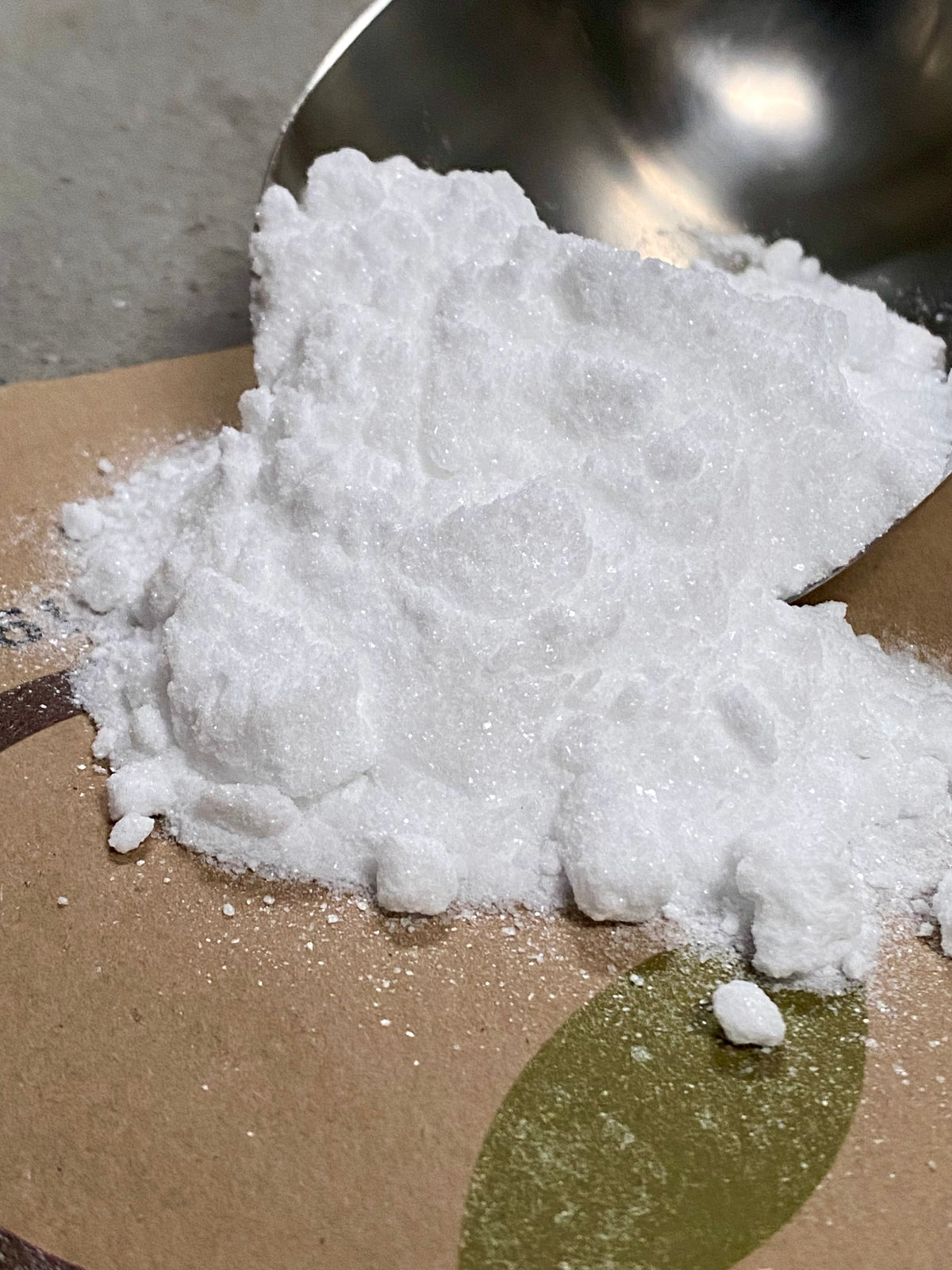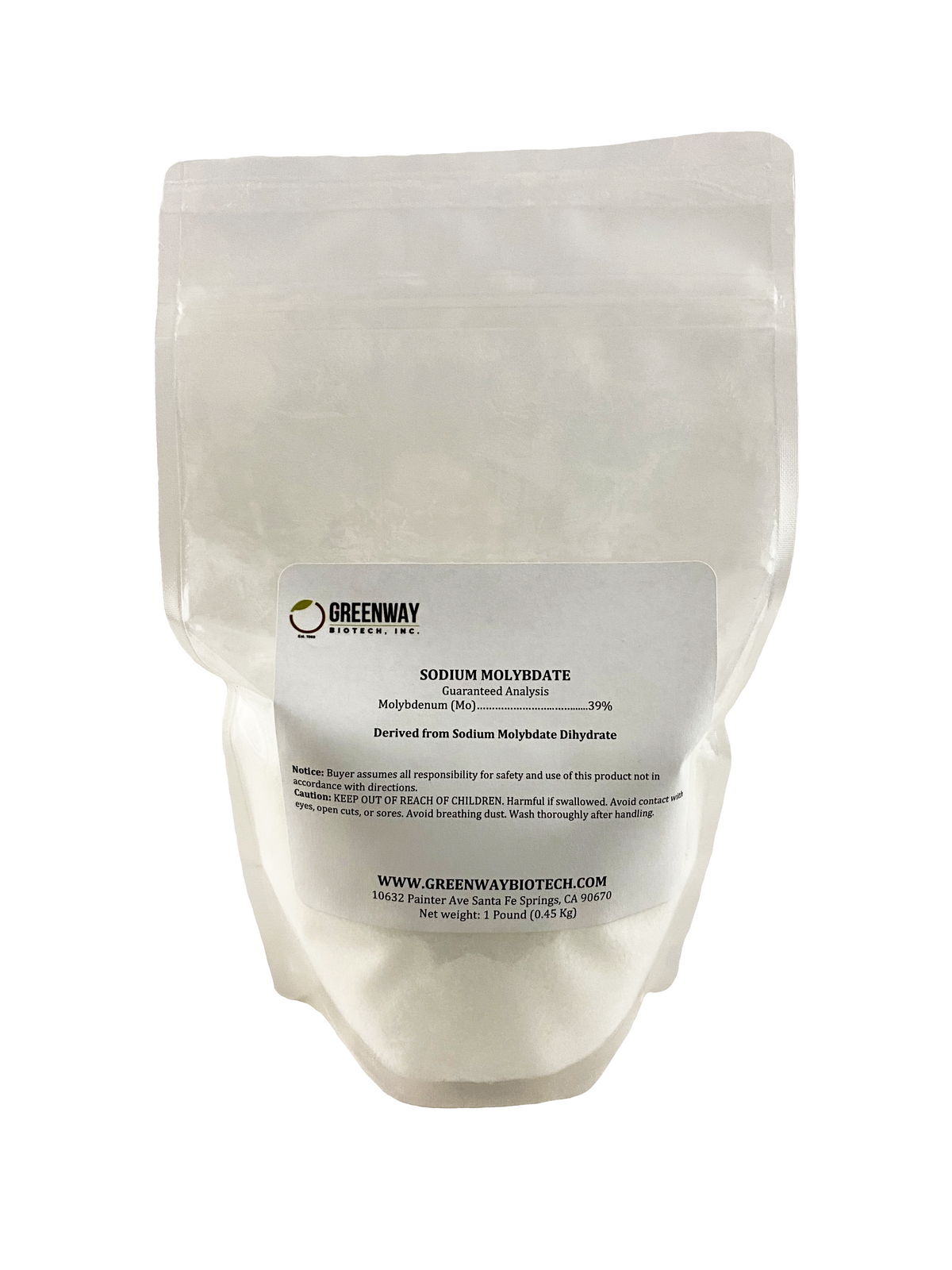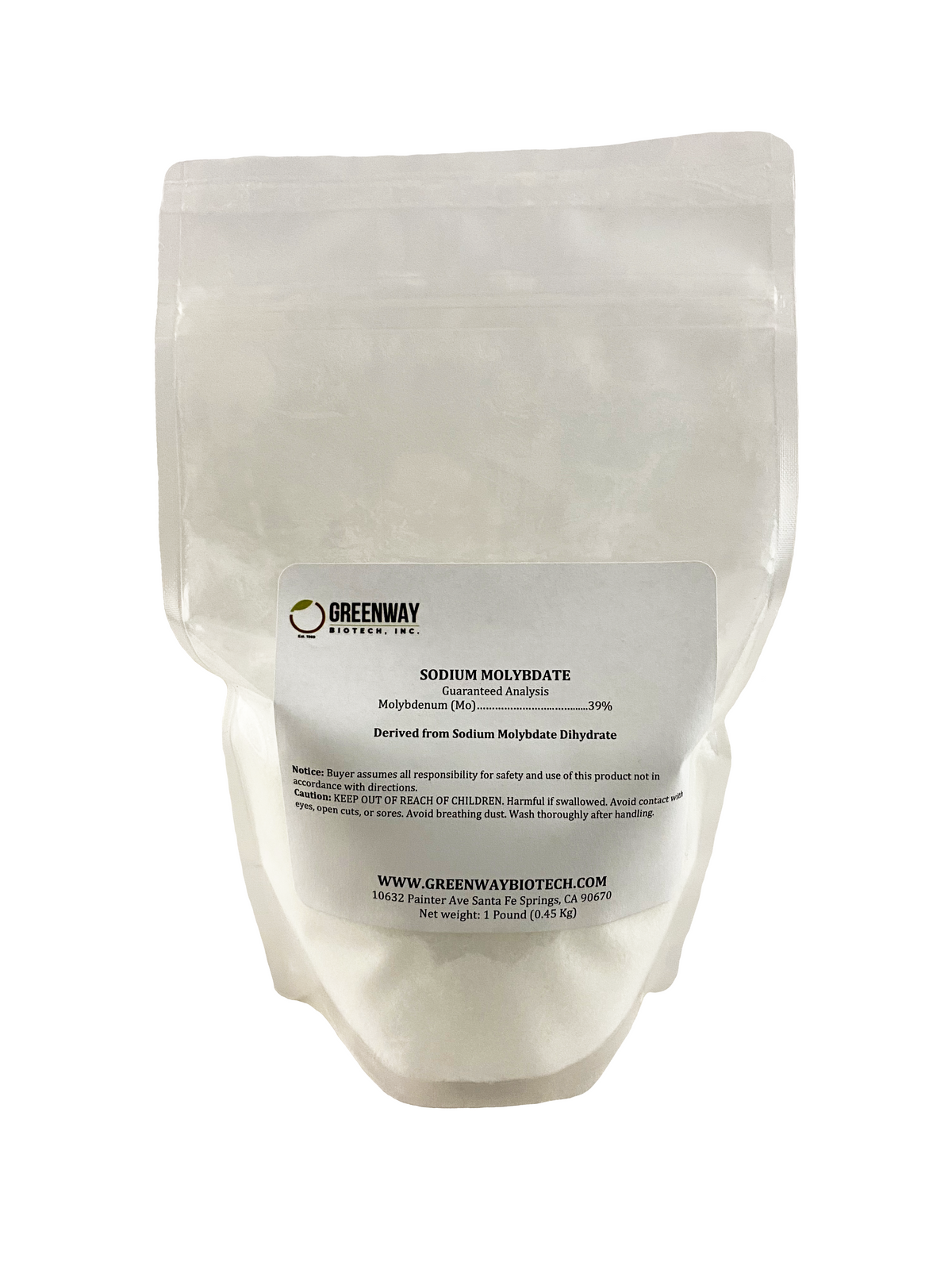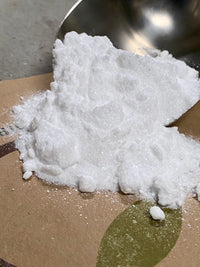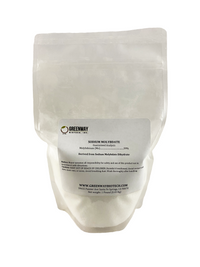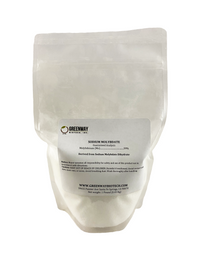Sodium Molybdate
- Regular Price
- $ 79.99
- Sale Price
- $ 79.99
- Regular Price
- Unit Price
- per
Sodium Molybdate Fertilizer (39% Molybdenum)
Premium micronutrient fertilizer containing 39% molybdenum — essential for nitrogen fixation in legumes, enzyme activation, and efficient nitrogen metabolism. 100% water-soluble for rapid correction of molybdenum deficiency in all crops.
Expected Results Timeline
Discover the power of sodium molybdate, an essential micronutrient fertilizer that plays a critical role in nitrogen metabolism and enzyme activation. Though required in trace amounts, molybdenum is vital for converting nitrate to amino acids and enabling nitrogen fixation in legumes. This highly water-soluble form ensures rapid availability and correction of deficiencies that can severely limit crop yields.
Perfect for legume crops, brassicas, and situations with high nitrate levels, sodium molybdate helps plants efficiently utilize nitrogen while preventing toxic nitrate accumulation. Its role in activating nitrogenase enzyme makes it indispensable for biological nitrogen fixation, reducing the need for synthetic nitrogen fertilizers and supporting sustainable agriculture practices.
Perfect For These Applications
Common Molybdenum Problems? We've Got Solutions
🌱 Nitrogen Fixation
Essential for nitrogenase enzyme in legumes, enabling biological nitrogen fixation and reducing synthetic N requirements.
⚡ Enzyme Activation
Activates nitrate reductase for efficient nitrogen metabolism and protein synthesis in all crops.
💧 100% Water Soluble
Completely dissolves for foliar, seed treatment, soil, or hydroponic applications with rapid plant uptake.
🎯 Trace Amounts
High 39% Mo concentration means only ounces per acre needed for season-long correction.
🛡️ Prevents Whiptail
Corrects molybdenum deficiency in cauliflower, broccoli, and other brassicas prone to distortion disorders.
♻️ Sustainable Choice
Enhances biological nitrogen fixation in legume rotations, reducing reliance on synthetic nitrogen fertilizers.
🔍 Molybdenum Deficiency Signs
⚠️ Important Application Guidelines
- Never exceed recommended rates — molybdenum can be toxic to livestock if forage contains over 5-10 ppm Mo
- Test before treating — conduct soil or tissue tests to confirm deficiency before application
- Acidic soils — Mo availability is severely limited below pH 6.0; consider liming as alternative correction
- Sulfur interaction — high sulfur levels can induce Mo deficiency; reduce sulfate applications if needed
- Livestock caution — excess Mo in forage can cause copper deficiency (molybdenosis) in grazing animals
- Application timing — seed treatment is most efficient; foliar best at 4-6 leaf stage before deficiency appears
Quick Dosage Guide
DERIVED FROM
Sodium Molybdate Dihydrate (Na₂MoO₄·2H₂O)
High-purity crystalline form provides maximum solubility and bioavailability for rapid correction of molybdenum deficiencies.
KEY FEATURES & BENEFITS
- High Molybdenum Content: 39% Mo ensures efficient correction with minimal application rates
- Nitrogen Metabolism: Essential for converting nitrate to amino acids and proteins
- Legume Performance: Critical for nitrogen-fixing bacteria in root nodules
- 100% Water Soluble: Ideal for foliar sprays, seed treatments, and fertigation
- Prevents Whiptail: Corrects molybdenum deficiency in cauliflower and brassicas
- pH Tolerance: Especially important in acidic soils where Mo availability is limited
- Trace Application: Only ounces per acre needed due to high concentration
- Sustainable Agriculture: Reduces need for nitrogen fertilizers in legume rotations
APPLICATION RATES & TIMING
Always conduct soil or tissue tests to confirm deficiency before application. Below are general guidelines — molybdenum is required in very small amounts, so accurate measurement is critical.
🌱 Seed Treatment
| Crop Type | Rate per 100 lbs Seed | Application Method |
|---|---|---|
| Legumes (Soybeans, Peas) | 1-2 oz | Slurry or dust application |
| Beans (Dry/Snap) | 1-2 oz | Apply with inoculant |
| Peanuts | 2-3 oz | Treat before planting |
| Alfalfa/Clover | 2-4 oz | Mix with coating material |
🍃 Foliar Application
| Crop | Rate per Acre | Timing |
|---|---|---|
| Cauliflower/Broccoli | 2-4 oz/acre | 4-6 true leaves |
| Soybeans | 1-2 oz/acre | V3-V5 stage |
| Canola | 1-3 oz/acre | 4-6 leaf stage |
| Sugar Beets | 2-3 oz/acre | 4-8 leaf stage |
🌾 Soil Application
| Method | Rate | Notes |
|---|---|---|
| Broadcast | 4-8 oz/acre | Best on acid soils (pH < 6.0) |
| Band with Fertilizer | 2-4 oz/acre | More efficient than broadcast |
| Fertigation | 1-3 oz/acre | Through drip or sprinkler |
💧 Hydroponic Solutions
| System | Concentration | Target Mo Level |
|---|---|---|
| General Hydroponics | 0.02-0.05 ppm Mo | In nutrient solution |
| Stock Solution | 1 oz/100 gallons | Dilute as needed |
SODIUM MOLYBDATE CALCULATOR
QUICK REFERENCE GUIDE
📋 Application Quick Reference
🌱 Seed Treatment
Rate: 1-4 oz/100 lbs seed
Best For: Legumes, beans, alfalfa
Advantages: Most efficient, season-long
🍃 Foliar Spray
Rate: 1-4 oz/acre
Best For: Quick correction, brassicas
Timing: 4-6 leaf stage
🌾 Soil Application
Rate: 2-8 oz/acre
Best For: Acid soils, long-term
Duration: 3-5 years
💧 Hydroponics
Rate: 0.02-0.05 ppm Mo
Best For: Soilless systems
Monitoring: Monthly checks
GROW WITH CONFIDENCE
Below are important details on quality, returns, sustainability, and charitable efforts that set our product apart.
Product Quality Guaranteed
- All our products are manufactured in California, USA
- Tested by independent third-party laboratories for quality assurance
- Registered with the California Department of Food and Agriculture (CDFA)
- Rigorously tested to ensure products are free from heavy metals
Hassle-Free Return Policy
If you're not completely satisfied, we offer a 90-day money-back guarantee. Simply return the unused portion in its original packaging, and we'll process a full refund.
Environmental Responsibility
We're committed to sustainable practices, including:
- Biodegradable packaging
- Precise nutrient formulation to reduce runoff
- Support for eco-friendly farming methods
Charitable Contributions
1% of all profits go to our foundation, focused on improving educational opportunities for children.
DOCUMENTS
- 📄 Material Safety Data Sheet (Coming Soon)
- 📋 Product Label / Spec Sheet (Coming Soon)
FREQUENTLY ASKED QUESTIONS
What is sodium molybdate and why is molybdenum important?
Sodium molybdate is a water-soluble fertilizer containing 39% molybdenum, an essential micronutrient required for two critical enzyme systems in plants. First, it's a component of nitrate reductase, which converts nitrate (NO₃⁻) to nitrite (NO₂⁻), the first step in converting nitrate nitrogen into amino acids and proteins. Second, it's essential for nitrogenase enzyme in nitrogen-fixing bacteria found in legume root nodules, enabling biological nitrogen fixation. Without adequate molybdenum, plants cannot efficiently use nitrogen, leading to stunted growth and nitrogen deficiency symptoms even when nitrogen is abundant.
How can I identify molybdenum deficiency in my crops?
Molybdenum deficiency symptoms vary by crop but commonly include:
- Whiptail in cauliflower: Leaves become narrow, strap-like, and distorted with ragged edges
- Yellowing in legumes: Pale green to yellow leaves similar to nitrogen deficiency
- Cup-shaped leaves: Upward cupping or rolling of leaf margins
- Scorched leaf edges: Necrotic margins on older leaves
- Poor nodulation: In legumes, pink nodules turn green/white and fix less nitrogen
- Stunted growth: Overall reduced plant size and delayed maturity
Deficiency is most common in acid soils (pH < 6.0) where molybdenum becomes less available, sandy soils with low organic matter, and after heavy rainfall that leaches molybdate ions.
What's the best application method for sodium molybdate?
The most efficient application methods depend on your crop and situation:
- Seed treatment (most efficient): Uses only 1-4 oz per 100 lbs seed, provides molybdenum exactly where needed, and lasts the entire season. Ideal for legumes.
- Foliar spray: Quick correction method using 1-4 oz/acre in 20-30 gallons water. Best applied at 4-6 leaf stage before deficiency symptoms appear.
- Soil application: Less efficient, requiring 4-8 oz/acre broadcast or 2-4 oz/acre banded. Best for long-term correction in acid soils.
- Liming alternative: Since liming increases Mo availability, it can correct deficiency in acid soils without direct Mo application.
Important: Never exceed recommended rates as molybdenum can be toxic to livestock if forage contains over 5-10 ppm Mo.
How does molybdenum interact with other nutrients?
Molybdenum has important interactions with several nutrients:
- Nitrogen: Mo is essential for N metabolism; without it, plants can't use nitrate nitrogen efficiently
- Phosphorus: High P can increase Mo uptake, while Mo deficiency reduces P utilization
- Sulfur: Sulfate and molybdate compete for uptake; high sulfur can induce Mo deficiency
- Copper: Antagonistic relationship — high Mo can induce copper deficiency in animals (molybdenosis)
- Iron: Mo deficiency can lead to iron accumulation in plants
- pH effect: Each unit increase in soil pH increases Mo availability 100-fold
For optimal results, maintain balanced nutrition and consider soil pH when planning Mo applications.
Is sodium molybdate safe for organic farming?
Yes, sodium molybdate is generally approved for use in organic farming systems, but always verify with your certifying agency. Key considerations for organic use:
- Allowed only when soil/tissue tests show deficiency
- Must document deficiency and application rates
- Cannot exceed rates necessary to correct deficiency
- Preferred sources are natural (though synthetic sodium molybdate is usually allowed)
- Seed treatment is often the preferred method in organic systems
The tiny amounts needed (often less than 0.1 lb/acre of actual Mo) make it environmentally sustainable and cost-effective for organic production.
How long does one application last?
Duration depends on application method: Seed treatment typically provides season-long correction for annual crops. Foliar applications may need repeating in subsequent years. Soil applications (broadcast or banded) generally last 3-5 years before reapplication is needed. In hydroponic systems, maintain continuous low levels of 0.02-0.05 ppm Mo in the nutrient solution with monthly monitoring.
Can I mix sodium molybdate with other fertilizers?
Yes, sodium molybdate is compatible with most fertilizers and can be tank-mixed for convenience. It works well in combination with nitrogen fertilizers, micronutrient blends, and foliar sprays. Avoid mixing with highly acidic materials as this can reduce Mo availability. When band-applying with starter fertilizer, sodium molybdate placement efficiency is increased. Always jar-test new combinations before large-scale mixing.
Why are my legumes not fixing nitrogen despite good inoculation?
Molybdenum deficiency is a common cause of poor nitrogen fixation in legumes. The nitrogenase enzyme requires Mo to function, so without adequate Mo, even well-inoculated legumes cannot fix atmospheric nitrogen effectively. Check for Mo deficiency by looking at nodule color — healthy nodules are pink/red inside, while deficient ones turn green or white. Seed treatment with 1-2 oz sodium molybdate per 100 lbs seed usually corrects this issue for the entire season.
